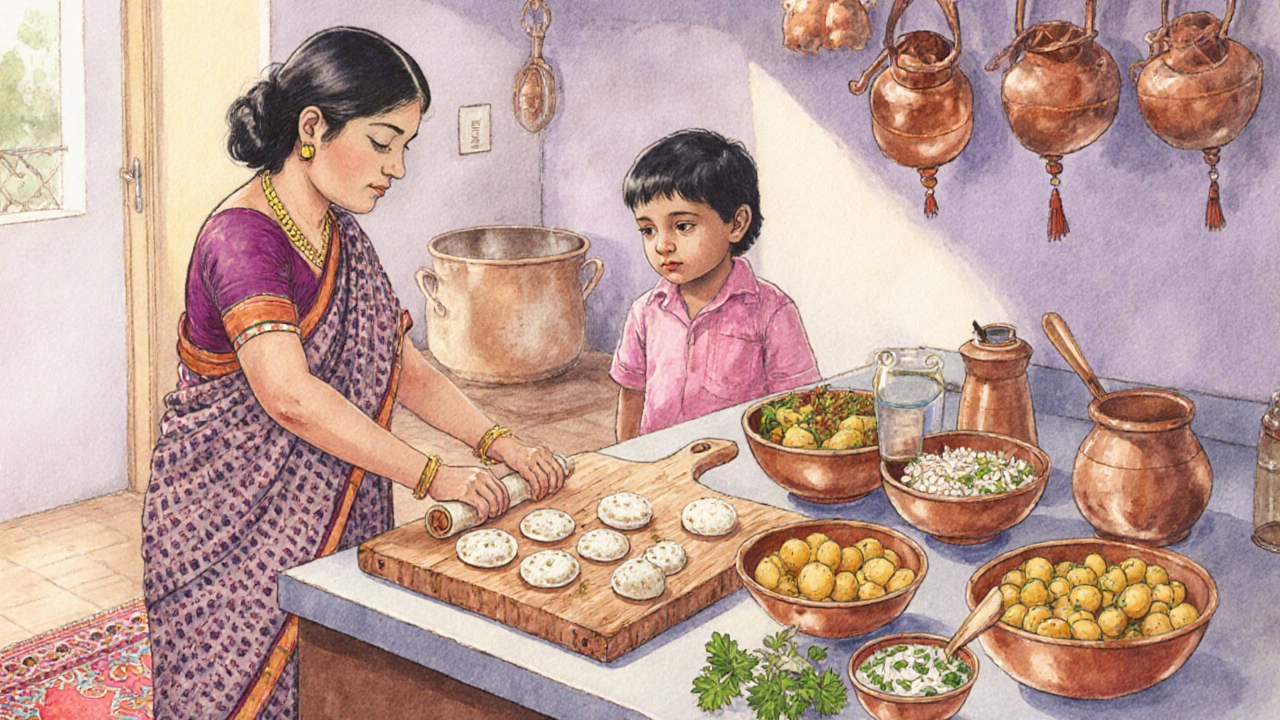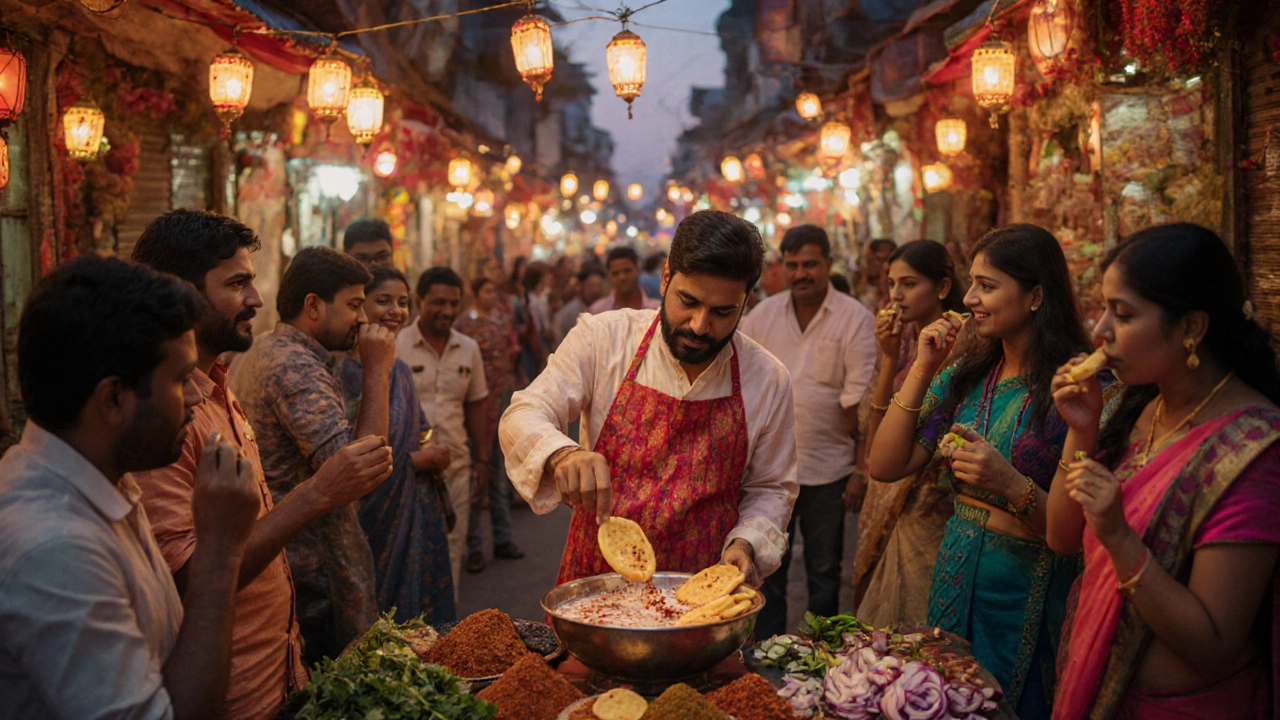29 Sep 2025
- 0 Comments
Pani Puri Cost & Nutrition Calculator
Customize your Pani Puri order and calculate the approximate cost and nutrition:
When you wander through any Indian market, the sound of vendors shouting, the scent of spices, and the sight of colorful bowls will greet you. Pani Puri is a bite‑size, hollow wheat‑flour sphere filled with tangy tamarind water, spiced potatoes, and chickpeas. Known as Golgappa in the north and Phuchka on the eastern coast, it’s the dish that most Indians point to when asked about their favorite street snack.
Quick Take
- Answer: the most common Indian street food is Pani Puri.
- It’s sold in every major city-from Mumbai’s bustling lanes to Delhi’s night markets.
- Affordability, portability, and a burst of flavors make it unbeatable.
- Regional twists turn the same basic concept into dozens of local favorites.
- Easy to recreate at home with a few pantry staples.
Why Pani Puri Tops the Street Food Charts
First, the price point is unbeatable. A single plate of 6‑8 puris costs anywhere from ₹15 to ₹30 (about $0.20‑$0.40) in most cities. That low cost means even a child’s pocket money can buy a round. Second, the snack is perfectly portable: each puri is a self‑contained mouthful, no fork or plate required. Third, the flavor profile-sweet, sour, salty, spicy, and crunchy-hits every taste bud in one bite, a quality Indian cuisine calls Chaat. Because it checks all the boxes, vendors find it impossible to resist setting up a small stall.
How Pani Puri Is Served Across Regions
Even though the core concept stays the same, the accompaniments shift dramatically. In Mumbai, you’ll get a tangy tamarind‑date chutney and a dash of roasted cumin powder. Up north, especially in Delhi, vendors add a generous spoon of spicy potato mash and a splash of mint‑coriander water. Head east to Kolkata, and the same puri becomes Phuchka, featuring a tamarind‑based broth spiked with black pepper and boiled potatoes. The variations keep the snack fresh, inviting repeat customers from one block to the next.

Simple Steps to Assemble Your Own Pani Puri at Home
- Buy ready‑made puri shells or fry small balls of semolina dough until puffed and crisp.
- Prepare the filling: boil potatoes, mash them, and mix with boiled chickpeas, chaat masala, and a pinch of salt.
- Make the water: blend tamarind pulp, jaggery, black salt, roasted cumin, mint, and coriander; thin with water to taste.
- Place 1‑2 teaspoons of the potato‑chickpea mix into each puri, add a few sprinkles of sev (crunchy gram flour noodles), and dip the whole thing into the chilled water.
- Enjoy immediately-once the puri absorbs the liquid, it softens and loses its crunch.
Feel free to experiment: add diced onions, boiled sprouts, or even sweet yogurt for a Dahi Puri twist. The base remains the same, so the dish evolves with your pantry.
Comparing Top Indian Street Snacks
| Snack | Primary Region | Main Component | Typical Price (₹) |
|---|---|---|---|
| Pani Puri / Golgappa / Phuchka | All major cities | Hollow puri + spiced water | 15‑30 |
| Bhel Puri | Maharashtra, Gujarat | Puffed rice + sev + tangy sauce | 20‑35 |
| Sev Puri | Maharashtra | Flat puri + potatoes + chutney + sev | 25‑40 |
| Dahi Puri | North India | Puri + yogurt + sweet‑spicy chutney | 30‑45 |
While all four snacks fall under the Chaat umbrella, Pani Puri leads in sheer volume of sales because it requires the least preparation time and the ingredients are universally accessible.
Tips for Enjoying Street Food Safely
- Watch the vendor’s hygiene: clean hands, fresh water bowls, and covered puri packets are good signs.
- Prefer stalls with a steady flow of customers-high turnover means fresher ingredients.
- Ask for the water to be served in a sealed container; avoid shared glasses.
- If you have a sensitive stomach, start with a half‑portion and see how your body reacts.
- Carry a small bottle of hand sanitizer for quick clean‑ups before digging in.
Frequently Asked Questions
What exactly is a puri?
A puri is a small, round, deep‑fried wafer made from semolina or wheat flour. It puffs up instantly, creating a hollow pocket perfect for holding fillings or flavored water.
Why does Pani Puri have so many names?
The snack traveled across linguistic borders. In Hindi‑speaking areas it’s called Golgappa, in Marathi‑speaking regions Pani Puri, and in Bengali‑dominant Kolkata it’s Phuchka. Each name reflects local pronunciation and slight ingredient tweaks.
Can I make Pani Puri gluten‑free?
Yes. Replace the wheat‑based puri with a rice‑flour or millet‑based version, which you can find in specialty stores or make at home using a rice‑flour dough.
How long does a plate of Pani Puri stay fresh?
Because the puris absorb water quickly, they’re best eaten within 10‑15 minutes of assembly. Vendors usually serve them fresh to avoid soggy shells.
Is Pani Puri healthy?
In moderation, it’s a balanced snack: carbs from the puri, protein from chickpeas, and vitamins from fresh herbs. The main downside is the oil used for frying, so occasional indulgence is fine.
